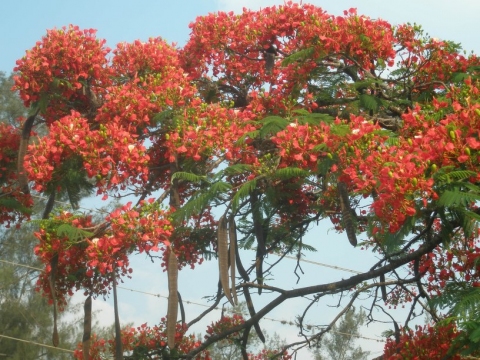Delonix regia (Hook.) Raf
Delonix regia is a fast-growing tree with an umbrella shaped, spreading crown with the long, nearly horizontal branches forming a diameter that is wider than the tree’s height. Usually evergreen, the trees are deciduous in areas where the dry season is long and pronounced. The tree grows 10 - 18 metres tall, with a large, buttressed bole that can attain a girth of up to 2 metres.A multipurpose tree, it is harvested from the wild for a wide range of local uses, including for medicines, food, timber, fuel and beads. It is cultivated as a shade tree in plantations and is used to stabilize and enrich the soil. This species is one of the most widely cultivated ornamental plants in the world, being grown as an ornamental in gardens and by the sides of roads throughout the tropics.Flame tree has become almost extinct in its native range of Madagascar.The main native subpopulations are found in areas that are threatened from charcoal production.he tree is classified as 'Vulnerable' in the IUCN Red List of Threatened Species(2010)
- Family: Fabaceae
- Habit: Evergreen Tree
- Habitat: Forests in warm humid areas at elevations from sea level up to about 1,000 metres
- Status : common
Vernacular names
Hindi: Gulmohar
• Bengali: Krishnachura
• Kannada: Kempu torai
Medicinal Uses
The leaves, flowers, seed and bark of this plant contain a range of medicinally active compounds, though the leaves are generally the richest source of most of these compounds. The plant is reported to have antibacterial, antidiabetic, antidiarrhoeal, antifungal, antiinflammatory, antimalarial, antimicrobial, antioxidant, cardio-protective, gastro-protective, hepato-protective and wound healing activity. It is used in folk medicine to treat a range of disorders, including constipation, inflammation, rheumatoid arthritis, diabetes, pneumonia, and malaria.The active compounds include flavonoids, alkaloids, saponins, sterols, beta-sitosterol, lupeol, tannins, carotenoids, and phenolic acids. Flavonoids and triterpenes have been shown to have analgesic activities and the flavonoids are also powerful antioxidants.The bark has medicinal properties.An aqueous extract has shown emetic properties.An aqueous extract of the flowers is active against roundworm.The metabolite-rich fractions of the sequentially extracted flowers and seeds have shown antifungal activity against Aspergillus niger, Aspergillus flavus, Rhizopus bataticola and Fusarium auxisporum.A leaf decoction presumably has anti-rheumatic effects.In eastern Nigeria the leaves are used traditionally for treating pain.The leaves contain flavonoids, phenolic compounds, triterpenes and sterols. A methanolic extract of the leaves has shown a significant analgesic potential.
An ethanol extraction of the leaves has been shown to exert a cardio-protective effect, at least partly due to its vasodilatory and antiinflammatory activity. It has also shown potential for improving liver and kidney functions whilst showing no negative side effects.
An essential oil obtained from the leaves has shown fungicidal properties.
